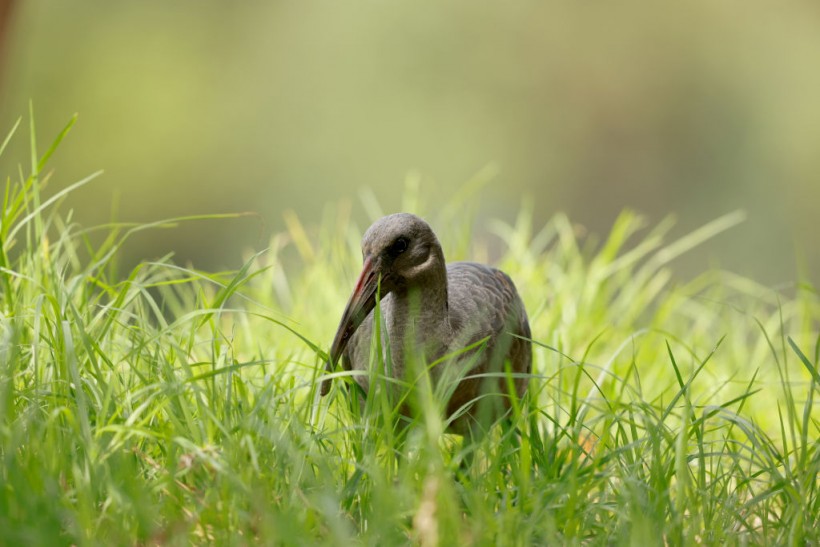A close-up of feathers from a bird that has an uncanny ability to hold water while flying may inspire the next generation of absorbent materials.
Researchers at Johns Hopkins University and the Massachusetts Institute of Technology used high-resolution microscopes and 3D technology to capture an unprecedented view of feathers from the desert-dwelling sandgrouse, showcasing the unique architecture of their feathers and revealing for the first time how they can hold so much water.
How An African Bird Might Inspire A Better Water Bottle
 (Photo : Warren Little/Getty Images)
(Photo : Warren Little/Getty Images)

"It's fascinating to see how nature created structures that are so perfectly efficient at taking in and holding water," said co-author Jochen Mueller, an assistant professor in the Department of Civil and Systems Engineering at Johns Hopkins who specializes in smart Materials and Design.
They believe that the findings could lead to new bio-inspired creations from an engineering standpoint, as per Phys.org.
To avoid predators, sandgrouse in African deserts typically nest about 20 miles from watering holes.
To bring water to thirsty chicks, adult males perform one of nature's best examples of carrying out, gathering water, and flying home with it, an extraordinary feat made even more remarkable given that the sandgrouse is carrying about 15% of his body weight in water and keeping most of it safe during a roughly 40 mph flight home that takes about a half hour.
The only birds known to hold water in this manner are male sandgrouse-their specially adapted belly feathers are the key.
Other researchers discovered these incredible belly feathers more than 50 years ago. However, it is only here, using modern technology, that the team can finally demonstrate how the feathers work.
Mueller and MIT engineer Lorna J. Gibson used scanning electron microscopy, microcomputed tomography, light microscopy, and 3D videography to examine the microstructure of the belly feathers, focusing on the shafts, which are only a fraction of the width of a human hair, and the even tinier individual barbules.
The feathers were examined under high magnification, both dry and wet. The dry feathers were then dunked in water, pulled out, and re-submerged, just like a sandgrouse at a watering hole, in a move as delicate as it was critical.
Mueller called the individual feather structure "magnificent," with components optimized to hold and retain water in a variety of ways, including how they bend, how the barbules form protective tentlike clusters when wet, and how tubular structures in each barbule capture water.
Individual feathers held the water in a forest of barbules near the shaft, with the curled barbules close to the tip acting almost like caps.
Possible applications include the development of netting for collecting and retaining water from fog and dew in desert regions, as well as the development of a water bottle that prevents annoying swinging and sloshing.
He's considering a design for a water bottle or sports backpack that safely holds a large amount of liquid but includes an inner feather-like system that keeps the water from swinging around while someone moves with it. He believes that runners would appreciate a hydration pack or water bladder that could do this.
He also envisions next-generation medical swabs that are easier to use, "where you can efficiently soak up liquid but it's much easier to release it," he says, noting that the release feature was a problem when collecting COVID-19 nasal test samples during the pandemic.
Also Read: African Tigerfish Seen Grabbing Bird Out of the Air in New Video [VIDEO]
Ways To Reduce Plastic Waste In Your Hotel
Single-use plastics have far-reaching environmental consequences in comparison to their benefits, as per UNESCO Sustainable Travel Pledge.
Another lump of worthless plastic is added to the ecosystem for the sake of making a cold beverage easier to drink or saving yourself a little washing up, and it may take centuries to fully degrade, causing a lot of damage in the process.
While plastic water bottles are relatively easy to recycle, those discarded in regular trash take 70-450 years to completely degrade.
With two bottles of water in each of a hotel's 100 rooms, that's at least 73,000 pieces of plastic thrown away by the hotel each year.
The simplest way to reduce waste is to buy water in glass bottles rather than plastic bottles. Of course, this increases the cost per unit slightly.
However, you can save money in the long run by installing a reverse osmosis water filtration system and purchasing reusable glass bottles.
Hotels went above and beyond by filtering all tap water, allowing guests to fill their glasses from the bathroom sink.
Related article: False Alarms: How the Fork-Tailed Drongo Lies its Way into a Free Meal
© 2024 NatureWorldNews.com All rights reserved. Do not reproduce without permission.





